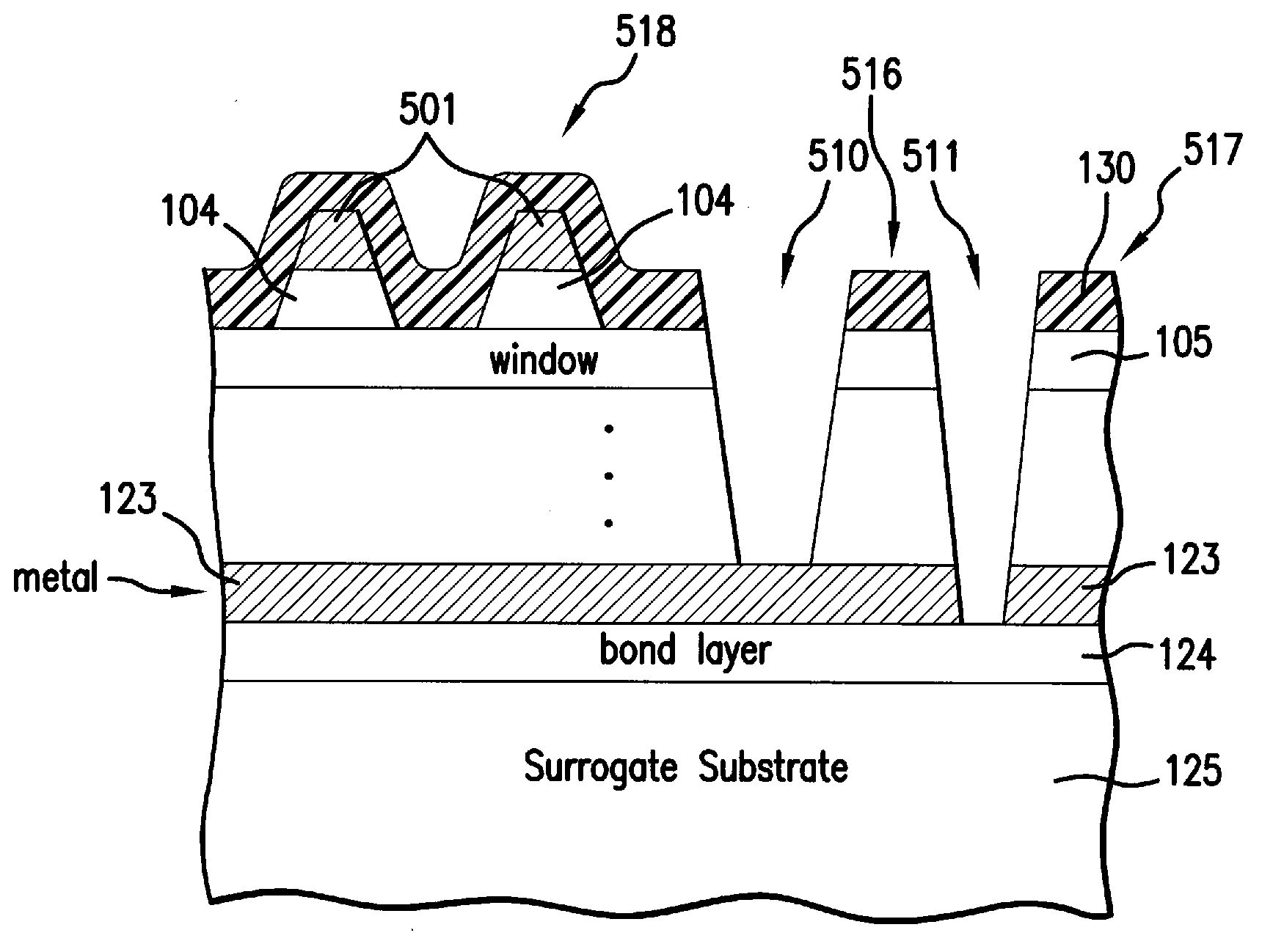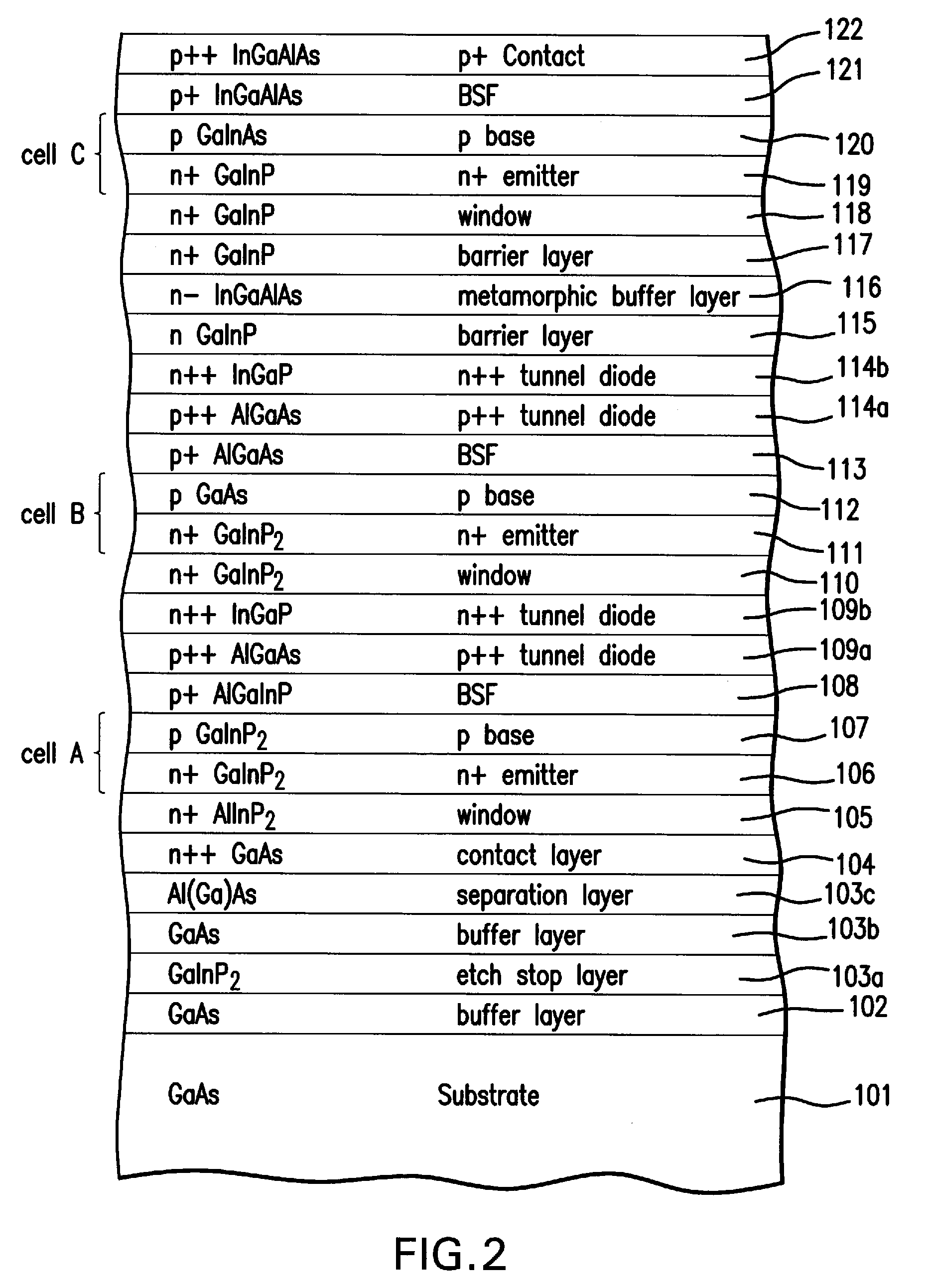Epitaxial Lift Off in Inverted Metamorphic Multijunction Solar Cells
a solar cell, inverted metamorphic technology, applied in the field of semiconductor devices, can solve the problems of presenting a number of practical difficulties, unable to produce a commercially viable and energy efficient inverted metamorphic multijunction solar cell using commercially established fabrication processes, and a more complex manufacturing process, etc., to achieve similar indices of refraction
- Summary
- Abstract
- Description
- Claims
- Application Information
AI Technical Summary
Benefits of technology
Problems solved by technology
Method used
Image
Examples
second embodiment
[0096]Although the preferred embodiment of the present invention utilizes a plurality of layers of InGaAlAs for the metamorphic layer 116 for reasons of manufacturability and radiation transparency, other embodiments of the present invention may utilize different material systems to achieve a change in lattice constant from subcell B to subcell C. Thus, the system of Wanlass using compositionally graded InGaP is the present invention. Other embodiments of the present invention may utilize continuously graded, as opposed to step graded, materials. More generally, the graded interlayer may be composed of any of the As, P, N, Sb based III-V compound semiconductors subject to the constraints of having the in-plane lattice parameter greater or equal to that of the second solar cell and less than or equal to that of the third solar cell, and having a bandgap energy greater than that of the second solar cell.
[0097]In another embodiment of the present invention, an optional second barrier l...
first embodiment
[0111]FIG. 8A is a side elevational view showing an epitaxially grown thin film semiconductor device being peeled from an underlying single crystal substrate by the etching technique generally according to the present invention. The semiconductor structure is immersed in a container 207 holding the etchant solution 206, and the figure depicts the surrogate substrate 125 and the epitaxial layers being released from the substrate 100, as the bubbles or reaction products 208 are released from the region of the separation layer 103c. The specific mechanical lifting technique depicted in FIG. 7 is only one representative embodiment, and accordingly the link elements 204 attached to a pulley 205 are not depicted to simplify the drawing.
[0112]FIG. 8B is a side elevational view showing an epitaxially grown thin film semiconductor device being peeled from an underlying single crystal substrate by the etching technique according to a second embodiment of the present invention. The semiconduct...
third embodiment
[0113]FIG. 8C is a side elevational view showing an epitaxially grown thin film semiconductor device being peeled from an underlying single crystal substrate by the etching technique according to the present invention. The semiconductor structure is immersed in a container 207 holding the etchant solution 206. A pliable member 211 is attached to the back surface of the surrogate substrate 125. A funnel shaped member 212 is attached to the center of the pliable member 211. Air suction 213 is then applied to the exterior of the funnel member 212, causing the pliable member 211 and substrate 125 to experience a force which increases with the distance from the center, so that along the periphery of the sides of the container 207, the solution 214 is pulled up and along the sides, and the ends of the pliable member 211 and the substrate 125 are also pulled up. This again allows the bubbles or reaction products 208 to be more rapidly released from the region of the separation layer 103c b...
PUM
 Login to View More
Login to View More Abstract
Description
Claims
Application Information
 Login to View More
Login to View More - R&D
- Intellectual Property
- Life Sciences
- Materials
- Tech Scout
- Unparalleled Data Quality
- Higher Quality Content
- 60% Fewer Hallucinations
Browse by: Latest US Patents, China's latest patents, Technical Efficacy Thesaurus, Application Domain, Technology Topic, Popular Technical Reports.
© 2025 PatSnap. All rights reserved.Legal|Privacy policy|Modern Slavery Act Transparency Statement|Sitemap|About US| Contact US: help@patsnap.com



